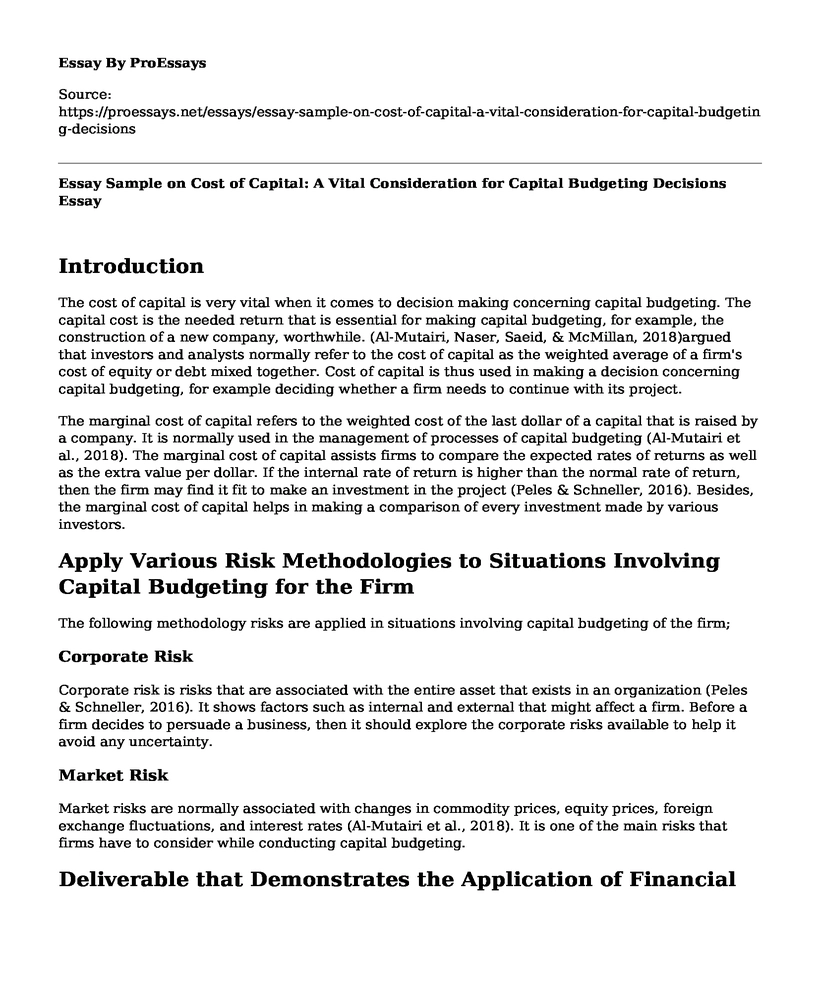Introduction
The cost of capital is very vital when it comes to decision making concerning capital budgeting. The capital cost is the needed return that is essential for making capital budgeting, for example, the construction of a new company, worthwhile. (Al-Mutairi, Naser, Saeid, & McMillan, 2018)argued that investors and analysts normally refer to the cost of capital as the weighted average of a firm's cost of equity or debt mixed together. Cost of capital is thus used in making a decision concerning capital budgeting, for example deciding whether a firm needs to continue with its project.
The marginal cost of capital refers to the weighted cost of the last dollar of a capital that is raised by a company. It is normally used in the management of processes of capital budgeting (Al-Mutairi et al., 2018). The marginal cost of capital assists firms to compare the expected rates of returns as well as the extra value per dollar. If the internal rate of return is higher than the normal rate of return, then the firm may find it fit to make an investment in the project (Peles & Schneller, 2016). Besides, the marginal cost of capital helps in making a comparison of every investment made by various investors.
Apply Various Risk Methodologies to Situations Involving Capital Budgeting for the Firm
The following methodology risks are applied in situations involving capital budgeting of the firm;
Corporate Risk
Corporate risk is risks that are associated with the entire asset that exists in an organization (Peles & Schneller, 2016). It shows factors such as internal and external that might affect a firm. Before a firm decides to persuade a business, then it should explore the corporate risks available to help it avoid any uncertainty.
Market Risk
Market risks are normally associated with changes in commodity prices, equity prices, foreign exchange fluctuations, and interest rates (Al-Mutairi et al., 2018). It is one of the main risks that firms have to consider while conducting capital budgeting.
Deliverable that Demonstrates the Application of Financial Analysis
Financial analysis refers to the process of evaluating projects, businesses, and other finance-related activities to establish their suitability and performance (Al-Mutairi et al., 2018). Following is a list of deliverables that can be used to demonstrate the various financial analysis applications:
- Analysis and data interpretation
- Collecting financial statements as well as other appropriate data
- Processing of data for proper adjustments
- Reporting the recommendations and conclusions
- Analyzing information
Why We Use After Tax Cash Flows in Calculations of WACC and How Tax Rates Affect the Calculations
The main reason why we use after-tax cash flow in the calculations of WACC is to help in maximizing the value of the stocks of a firm as the prices of stocks are dependent on after-cash tax flows (Al-Mutairi et al., 2018). Peles and Schneller (2016) argued that as the tax rates of the corporate increase the company's WACC decreases because higher rates generate a bigger tax shield as opposed to the case of before-tax cash flow
Conclusions
Before a firm commits to investing in any activity, it has to determine the kind of transactions it needs declines and the ones it should accept. This is only possible when there is an efficient capital budgeting. Before a business commits in investing in other assets, it has to evaluate certain risks to help it ascertain the viability and suitability of the process. Furthermore, the business needs to consider undertaking its financial analysis to help it establish its financial position.
References
Al-Mutairi, A., Naser, K., Saeid, M., & McMillan, D. (2018). Capital budgeting practices by non-financial companies listed on the Kuwait Stock Exchange (KSE). Cogent Economics & Finance, 6(1), 1468232. https://doi.org/10.1080/23322039.2018.1468232
Peles, Y., & Schneller, M. (2016). Financial Ratios and The Analysis of Marketing Policy. European Journal Of Marketing, 16(5), 12-21. https://doi.org/10.1108/eum0000000004849
Cite this page
Essay Sample on Cost of Capital: A Vital Consideration for Capital Budgeting Decisions. (2023, Apr 08). Retrieved from https://proessays.net/essays/essay-sample-on-cost-of-capital-a-vital-consideration-for-capital-budgeting-decisions
If you are the original author of this essay and no longer wish to have it published on the ProEssays website, please click below to request its removal:
- Government Spending and Taxes - Essay Example
- McDonalds Financial Analysis Paper
- Essay Example on Trading Options
- Implications of Future Income and Estate Taxes Essay
- Operating Budget Estimates - Essay Sample
- Essay on Affordable Health Insurance Marketplaces: Government Policies for Managing Healthcare
- Essay Example on Differences Between Domestic and International Banks







